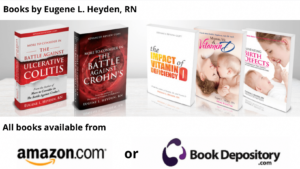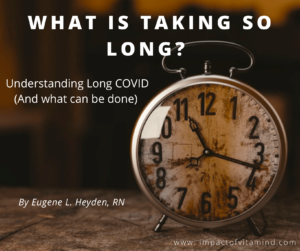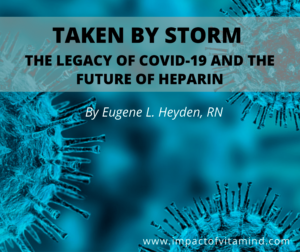Topic: Lumbrokinase; Long COVID; COVID-19
Download a PDF of the entire article
By Eugene L. Heyden, RN
Introduction
“Studies have shown that long covid can affect the whole spectrum of people with covid-19, from those with very mild acute disease to the most severe forms.
“The symptoms of long covid include fatigue, dyspnea, cardiac abnormalities, cognitive impairment, sleep disturbances, symptoms of posttraumatic stress disorder, muscle pain, concentration problems, and headache.” ~Crook et al., 2021
In a related article, I shared with you two procedures for Long COVID that may make it all go away, and rather quickly—namely, H.E.L.P. apheresis and Therapeutic Plasma Exchange. Unfortunately, both procedures are not generally offered to treat Long COVID, are too expensive for the average person to afford, and are not readily available. But there may be an alternative way to approach the fundamental problem in Long covid. There is a unique dietary supplement that just might do the trick. Let’s explore the possibilities. But first, there are a few things we need to get out of the way.
How you got to where you are today
“Severe SARS-CoV-2 infection mostly presents with coagulation abnormalities, pulmonary microvascular thrombosis, and severe inflammatory response.” ~Fard et al., 2021)
“Coagulopathies [coagulation abnormalities], and especially the formation of extensive microclots in vivo, are a hallmark of both COVID and long COVID, and we have demonstrated that these microclots too are amyloid in character.” ~Kell et al., 2022, emphasis added
Very briefly, a couple of years ago a novel respiratory virus, SARS-CoV-2, arose from Wuhan China, rapidly spread across the globe to eventually kill millions. Somehow it found you. Somehow it infected you. Thankfully, you did not perish. You survived. But things, they have never been the same. Something unseemly is going on behind the scenes, it is not pretty, and it is just not going away.
As it turns out, what is going on is rather simple. You have a clotting disorder, one that impairs tissue oxygenation (Kell, et al., 2022; Wang et al., 2022). And this clotting disorder exists because of the unique way the body responds to a certain portion of the virus called the spike protein—the wiggly little things that project from the body of the virus and are used to achieve attachment to a target cell. Would you like to see what the virus looks like? Check it out! https://rb.gy/golxfs
Now, back to our story.
One intriguing way the body defends against an advancing respiratory virus is to utilize a sophisticated defense mechanism known as immunothrombosis. Immunothrombosis defends against viral penetration into the systemic circulation by clot formation (AKA thrombus formation) at the point of entry—occurring within the capillary bed, most notably in the lungs. Apparently, the spike protein is the trigger for such clotting to take place (Kell et al., 2022), and a heroic effort is put forth to freeze the virus in place. Although well-intentioned, this can occur extensively and lead to noticeably impaired gas exchange in the lungs and reduced oxygenation of tissues and organs. And this leads to a variety of symptoms. Did you know, immunothrombosis is one of the things you experienced as you were battling COVID? Are you following me? It’s not all that hard, is it? Well, things do get a little more complex.
In immunothrombosis, the coagulation system, along with a cell called the platelet (which can engulf the virus to isolate and disable it)—in addition to a variety of clotting factors—all act together as a defense mechanism. Even the disturbed vascular wall lining, called the endothelium, becomes intimately involved, signaling that clot formation would be a very good idea. Surprisingly, clot formation is not exclusive to the acute COVID-19 infection, it is occurring in Long COVID as well. Indeed, we should view Long COVID is a clotting disorder.
“Ongoing vascular endothelial damage promotes platelet adhesion and coagulation, resulting in the impairment of various organ functions. Meanwhile, thrombosis will further aggravate vasculitis contributing to further deterioration. Thus, long COVID is essentially a thrombotic sequela.” (Wang et al., 2022, emphasis added)
Contemplating its very essence, it is easy to see why Long COVID expresses itself in a variety of ways. Clotting, occurring within the capillary bed, leading to impaired tissue oxygenation, wherever it occurs, explains the persistent fatigue, the brain fog, the cognitive impairment, the shortness of breath, that are the hallmarks of Long COVID. Surprisingly, Long COVID remains long because the clots keep on forming. And they keep forming because the trigger does not easily or quickly go away (Kell et al., 2022, emphasis added).
Recall, spike protein exposure is a trigger for defensive clotting. And with respect to Long COVID, “There is now considerable evidence for the persistence of SARS-CoV-2.” (Kell et al., 2022, emphasis added) It has been discovered that the SARS-CoV-2 virus, or parts thereof, can persist, circulating within the affected individual for months! Indeed, one group of investigators discovered fragments of the SARS-CoV-2 pike protein within a circulating white blood cell called the monocyte—identified 15 months following the original COVID-19 infection (Patterson et al., 2022; Kell et al., 2022). Great! The spike protein fragment is isolated within the body of a monocyte where it cannot evoke a regional immune response or trigger aberrant clotting. But although the life of the monocyte is somehow prolonged past its typical one-day lifespan, monocytes eventually die (by the millions each day) and spill their contents (see Patterson et al., 2022). And likely, this is one of the mechanisms whereby sequestered spike protein fragments are repeatedly released into the circulation to evoke the host response that translates into clot formation, leading to the extensive capillary blockage we see in Long COVID (Kell et al., 2022). So, although you have defeated the enemy during an initial struggle (for life), you are reacting to the body parts of the virus left behind. Consider this:
“It is important to note that the S1 [spike] protein detected in these patients appears to be retained from prior infection or phagocytosis of infected cells undergoing apoptosis [programmed cell death] and is not the result of persistent viral replication.” (Patterson et al., 2022)
Furthermore,
“Many pieces of research-level evidence (especially suggest strongly that fibrin amyloid microclots, driven by the presence of the SARS-CoV-2 spike protein, are an inevitable accompaniment to (and a likely cause of) Long COVID.” (Kell et al., 2022)
I’m sure you are thrilled with all this new-found knowledge and want to learn more. I am very pleased with you attitude.
Recently, it was discovered . . .
To continue reading, click here: [Lumbrokinase for Long Covid]
Related posts (Click on image to open)
Topic: Lumbrokinase; Long COVID; COVID-19
References
Crook H, Raza S, Nowell J, Young M, Edison P. Long covid—mechanisms, risk factors, and management. bmj. 2021 Jul 26;374. https://www.bmj.com/content/374/bmj.n1648.abstract
Fard MB, Fard SB, Ramazi S, Atashi A, Eslamifar Z. Thrombosis in COVID-19 infection: Role of platelet activation-mediated immunity. Thrombosis Journal. 2021 Dec;19(1):1-1. https://link.springer.com/article/10.1186/s12959-021-00311-9
Kell DB, Laubscher GJ, Pretorius E. A central role for amyloid fibrin microclots in long COVID/PASC: origins and therapeutic implications. Biochemical Journal. 2022 Feb 17;479(4):537-59. https://portlandpress.com/biochemj/article-abstract/479/4/537/230829
Patterson BK, Francisco EB, Yogendra R, Long E, Pise A, Rodrigues H, Hall E, Herrera M, Parikh P, Guevara-Coto J, Triche TJ. Persistence of SARS CoV-2 S1 protein in CD16+ monocytes in post-acute sequelae of COVID-19 (PASC) up to 15 months post-infection. Frontiers in Immunology. 2022:5526. https://www.frontiersin.org/articles/10.3389/fimmu.2021.746021/full?s=09
Wang C, Yu C, Jing H, Wu X, Novakovic VA, Xie R, Shi J. Long COVID: The Nature of Thrombotic Sequelae Determines the Necessity of Early Anticoagulation. Frontiers in Cellular and Infection Microbiology. 2022;12. https://www.ncbi.nlm.nih.gov/pmc/articles/PMC9016198/
DISCLAIMER: This article is offered solely for informational purposes. The information contained therein and opinions expressed should be evaluated for accuracy and validity in the context of opposing data, new information, and the views and recommendations of a qualified health care professional, and not to be substituted for professional judgment and guidance or to provide a reason to neglect or delay appropriate medical care for self or for others. It is the reader and reader only who bears the responsibility for any actions that could be construed as being a response to the information presented. The statements and opinions expressed by the author have not been reviewed or approved by the FDA or by any other authoritative body, nor is the author endorsing any product or specific therapy mentioned. This article and the opinions contained therein are offered to the reader to broaden his or her understanding of the issues discussed and to help identify options that may be suitable for the individual to pursue, on behalf of self or others, under approval and direction of a qualified physician or medical team member. All questions of a medical nature which arise from reading this article should be directed at qualified health care professional. There are no guarantees that a suggested website and internal links are safe to visit or open or are currently available.
Copyright © 2022 Eugene L. Heyden, RN
All Rights Reserved.

DISCLAIMER: The book excerpts and articles featured on this website are offered solely for informational purposes. The information contained therein should be evaluated for accuracy and validity in the context of opposing data, new information, and the views and recommendations of a qualified health care professional, and not to be substituted for professional judgment and guidance or to provide a reason to neglect or delay appropriate medical care for self or for others. It is the reader and reader only who bears the responsibility for any actions that could be construed as being a response to the information presented. The statements and opinions expressed by the author or authors of the information provided on this website have not been reviewed or approved by the FDA or by any other authoritative body, nor is the author endorsing any product or specific therapy mentioned. The book excerpts, articles, statements, and opinions are offered to the reader to broaden his or her understanding of the issues discussed and to help identify options that may be suitable for the individual to pursue, on behalf of self or others, under approval and direction of a qualified physician or medical team member. All questions of a medical nature which arise from the book excerpts and articles available on this website should be directed at qualified health care professional.












